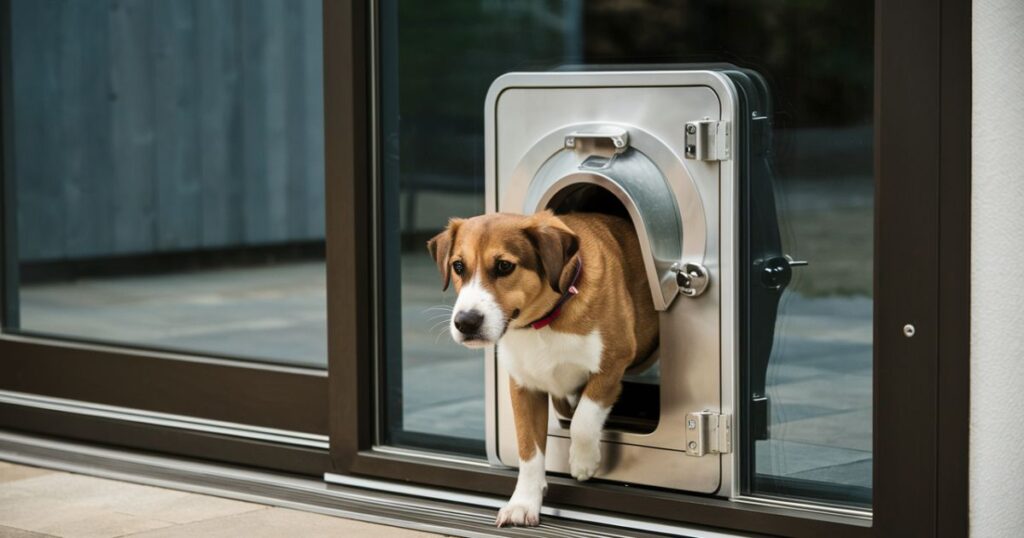A doggy door for a sliding glass door is a small opening designed specifically for pets to pass through. It allows dogs and cats to enter or exit the house without needing human assistance. These doors typically feature a flap or panel that can be pushed or swung open by the pet.
A doggy door for a sliding glass door is like a special entrance just for pets. It lets them go in and out of the house on their own without needing to ask humans for help. With a simple flap or panel, pets can come and go freely, making life easier for both them and their owners.
It is for a sliding glass door is a convenient way for pets to move in and out of the house independently. It’s typically a small opening with a flap or panel that pets can push through. This feature allows pets to enjoy freedom while maintaining security in the home.
Types of Doggy Doors
Types of doggy doors vary based on size, design, and installation method. They can be categorized into standard flap doors, electronic doors, and patio panel doors. Standard flap doors are basic and affordable, electronic doors use sensors or microchips for controlled access, and patio panel doors fit into existing sliding glass doors for easy installation.
| Type | Fits into existing sliding glass doors, convenient for installation. |
| Standard Flap | Fits into existing sliding glass doors, convenient for installation. |
| Electronic | Controlled access using sensors or microchips, provides security. |
| Patio Panel | Fits into existing sliding glass doors, convenient installation. |
Related Content: Sliding Glass Doggie Door
Benefits of Installing a Doggy Door in a Sliding Glass Door
Installing a doggy door in a sliding glass door offers numerous benefits for both pets and their owners. Firstly, it provides pets with the freedom to go outside whenever they need to relieve themselves or enjoy some fresh air, reducing accidents indoors and promoting their overall well-being.
It relieves owners of the constant need to open and close doors for their pets, saving time and effort throughout the day. A doggy door in a sliding glass door enhances home security by allowing pets to access the yard without leaving the main door open, reducing the risk of intruders gaining entry. This added convenience also fosters a sense of independence in pets, as they can come and go as they please, leading to happier and more content animals.
Convenience for pet owners
A doggy door in a sliding glass door provides unmatched convenience for pet owners. With this feature, owners no longer need to interrupt their tasks or activities to let their pets in or out of the house. This saves time and hassle, allowing owners to focus on other important responsibilities.
It reduces the chances of accidents inside the home due to pets needing to relieve themselves. Ultimately, the convenience of a doggy door leads to happier pets and more relaxed owners.
Reduction in energy costs
A doggy door in a sliding glass door can lead to a reduction in energy costs. By allowing pets to come and go freely, there’s less need for owners to constantly open and close doors, which helps maintain indoor temperatures more efficiently.
This can result in lower heating or cooling expenses over time. Plus, it promotes environmental sustainability by conserving energy.
Minimized scratching and damage to doors
A doggy door in a sliding glass door helps minimize scratching and damage to doors. Pets no longer need to scratch or paw at doors to signal their desire to go outside, reducing wear and tear on door surfaces. This preserves the appearance and integrity of the doors, extending their lifespan. It saves owners from the hassle and cost of repairing or replacing damaged doors.
Potential Drawbacks and Solutions
While installing a doggy door in a sliding glass door offers numerous benefits, there are potential drawbacks to consider. One concern is security, as traditional doggy doors may provide an entry point for intruders. Some pets may struggle to adapt to using the door, leading to accidents or behavioral issues.

Fortunately, there are solutions to mitigate these drawbacks. Owners can opt for electronic doggy doors equipped with sensors or microchips to ensure controlled access and enhance security. Training and patience can help pets adjust to using the door properly, with positive reinforcement encouraging successful transitions.
Also Read This Blog: Sliding Door Doggie Door
Security concerns
Security concerns arise with the installation of a doggy door in a sliding glass door. Traditional doggy doors may pose a risk of unauthorized entry by intruders, compromising home security. Measures such as using electronic doggy doors with advanced locking systems can help address these concerns and provide peace of mind to homeowners.
Invasive installation process
The installation process for a doggy door in a sliding glass door can be invasive, involving cutting into the glass or altering the frame. This procedure may require professional expertise to ensure a proper fit and minimize potential damage to the door or surrounding structure.
- Installing a doggy door in a sliding glass door can involve invasive procedures.
- This may require cutting into the glass or altering the frame, which can be a complex and potentially risky process.
- Professional installation is often recommended to ensure proper fitting and to minimize the risk of damage to the door or surrounding structure.
Weather-related issues
Weather-related issues can arise with the installation of a doggy door in a sliding glass door. These include drafts, leaks, or heat loss during colder months, as well as potential issues with insulation and water damage during rainy or humid weather. Proper weatherproofing and sealing measures are essential to address these concerns and maintain the comfort and integrity of the home.
Frequently asked questions
How does a doggy door in a sliding glass door work?
Typically, a doggy door in a sliding glass door features a flap or panel that pets can push through to go in or out. Some may also have electronic mechanisms for controlled access.
Are there different sizes of doggy doors available for sliding glass doors?
Yes, doggy doors for sliding glass doors come in various sizes to accommodate different breeds of pets, from small dogs and cats to larger breeds.
Can I install a doggy door in a sliding glass door myself?
While it’s possible to install a doggy door in a sliding glass door yourself, it’s often recommended to seek professional installation to ensure proper fitting and minimize the risk of damage to the door or surrounding structure.
What are the security considerations when installing a doggy door in a sliding glass door?
Security is a concern with traditional doggy doors, as they may provide an entry point for intruders. Opting for electronic doggy doors with advanced locking systems can help address these concerns.
How can I weatherproof a doggy door in a sliding glass door to prevent issues?
Weatherproofing measures such as proper sealing and insulation are essential to prevent drafts, leaks, and heat loss during colder months, as well as water damage during rainy or humid weather
Conclusion
It is for a sliding glass door that offers significant benefits for both pets and their owners. It provides pets with the freedom to move in and out of the house independently, reducing accidents indoors and promoting their overall well-being. It saves owners time and effort by eliminating the need to constantly open and close doors for their pets, leading to a more convenient and stress-free experience.
While there may be some drawbacks such as security concerns and invasive installation processes, these can be mitigated with proper precautions and professional assistance. Overall, the convenience, independence, and improved quality of life for both pets and owners make investing in a doggy door for a sliding glass door a worthwhile decision.

Warner Clips is an expert writer with 4 years of experience crafting engaging content on Home topics. My expertise ranges from creating cozy environments to tackling Home Improvement projects. Find my work in publications like Huffington Post and Reader’s Digest.







